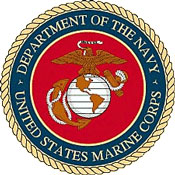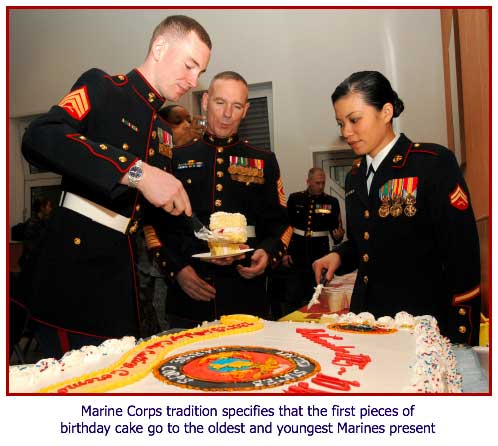
U.S. Marine Corps
Founded by a Man of Peace

Marine Corps Founded in Philadelphia
by Quaker Samuel Nicholas
It seems a bit ironic that the United States Marine Corps, traditionally known as America's fiercest fighting force, was founded by a member of the Religious Society of Friends (a Quaker), a religious sect known for its pacifism.

Few are the Proud who remember.
Each year, for the past twenty plus, a small contingent of the Few and the Proud marks the Marine Corps Birthday on November 10 with a sunrise 3.5-mile memorial run from the University of Pennsylvania to the burial site of Major Samuel Nicholas at the Quaker meeting house at Fourth and Arch Streets in downtown Philadelphia. Most are Navy ROTC cadets from Penn and Villanova who have opted to become Marines upon graduation, although other Marines sometimes join them.
Peter Mucha of the Philadelphia Inquirer reported:
|
"It's an obscure ritual at a hardly noticed resting place - an almost-unknown tomb of a well-known soldier. No gravestone marks the spot, and no sign or engraving commemorates his life. The Religious Society of Friends, renowned for its pacifism, has kept the matter quiet - a remarkable feat in a city that worships history-makers. About 6:40 a.m., hearty chanting heralded the approach of a contingent of men and women. "Back in 1775, our Marine Corps came alive!" was one of the lines they bellowed. . . . The cadence grew louder as about 48 souls, most of them in sweat suits with bright reflective tape, jogged double-file through the Arch Street gates, a block west of the Betsy Ross abode. . . . [They stood] silently on a herringbone brick walkway west of the long two-story brick edifice, under a semi-skeletal canopy of towering trees. A reading commemorated the life of the Marine Corps' first commandant, who was given authorization to recruit its first battalions by the Continental Congress [238] years ago. Leading Marines during the Revolutionary War, Nicholas launched a successful assault on British forces in Bermuda and ferried Gen. George Washington across the Delaware River for the Battle of Trenton. That the observance falls on the day before Veterans Day is mere coincidence. A wreath with red and white carnations and a red bow was placed upon a wire stand, followed by a minute or more of silence. Then the group was off, except for Capt. Phillip Peche, who stayed behind to explain. The 48 paying homage - who ran 3-1/2 miles from the University of Pennsylvania - included about 40 ROTC cadets from Penn and Villanova University, as well as three second lieutenants and a gunnery sergeant from Quantico, Va. The ROTC program is officially a Navy program, but cadets [actually, they're midshipmen] can opt to join the Marine Corps. "I think it's great to introduce the newest members of the corps to the history," he said. Exactly where Nicholas' remains lie is a mystery, however, he said. Near the entrance walkway, a horizontal slab bears this inscription: "Beneath this stone lies the body of Doct Edward Owen, who desired while living that after his burial he migh not be disturbed." The only other identifiable grave marker on the grounds, officials say, is the one in southeast corner for the 19th-century Mayor Richard Vaux. Some reports claim Nicholas was buried on the east side of the building, but no one really knows, former meetinghouse director Helen J. File said. "We don't have a clue," she said. The ceremony has been observed for more than 20 years, and usually the wreath was placed at the eastern end of the property, she said. But Nicholas' whereabouts weren't a factor. For one reason, the east side has a wrought-iron fence to hang the wreath on. "The other thing is, it was out of sight," she said. File, director for 28-1/2 years, allowed the annual ceremony, as long as it was small and quiet. "Without any guns or fanfare," she said. Not knowing the grave location isn't surprising, current director Nancy Gibbs said. Quakers don't subscribe to fancy headstones, and as cemeteries go, it was anything but exclusive. As many as 20,000 people - including thousands of casualties of the yellow-fever epidemic of the late 18th century - may have been buried on the property, which William Penn chartered as a cemetery in 1701, she said. The meetinghouse, finished in 1811, was built atop remains, she said. "They're still here," she said. "They're under our feet. They're under our parking lot. They're under our walkways." In the late 1990s, a written request was made to remedy the situation by installing a small marker just for Nicholas. "It was denied," File said. Nicholas was a Quaker until he decided to fight for the country's independence and started recruiting at Tun's Tavern to form the Marine Corps, according to accounts. He was then expelled - Quakers call it being "read out of meeting," Gibbs said. Research never could confirm whether he attended meetings again later in his life, File said. Nevertheless, his remains were buried there. Unmarked by any stone."
|
A reader who commented on the story at Military.com remarked: "It is fitting and just that such a great fighting force in the pursuit of freedom for all mankind should have been founded by a Pacifist, a man who knew there are some things worth fighting for, even when he was brought up to believe that war was wrong."
Please, use the buttons across the bottom of the page to share this article on Facebook and Twitter, and
If you'd like to search the site for more pages about the Marines, or another topic, just type your search query here:






New! Comments
Join our conversation! Leave me a comment about this page in the box below. If your comment is about another page on this site, please leave your comment on that page, because I have no ability to move it to the correct page. Thanks!